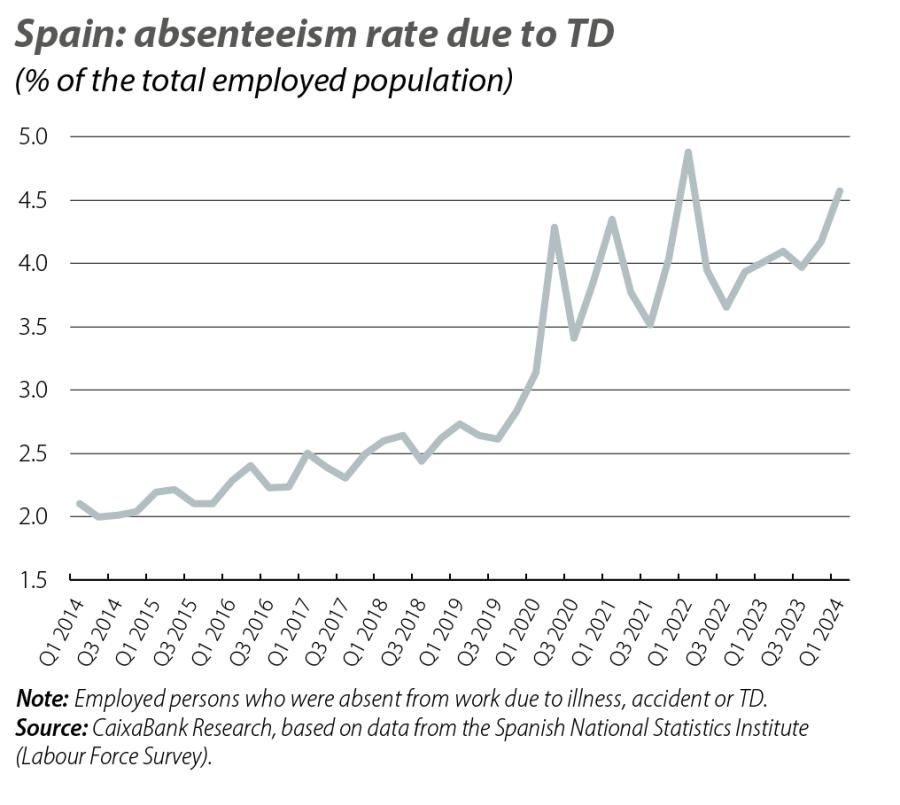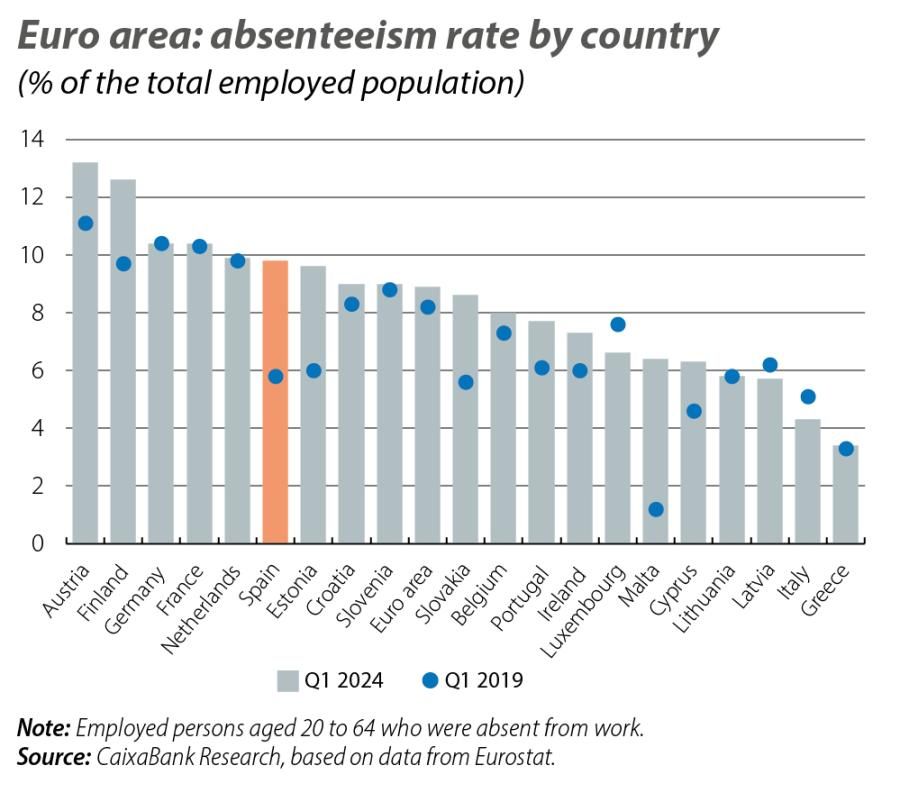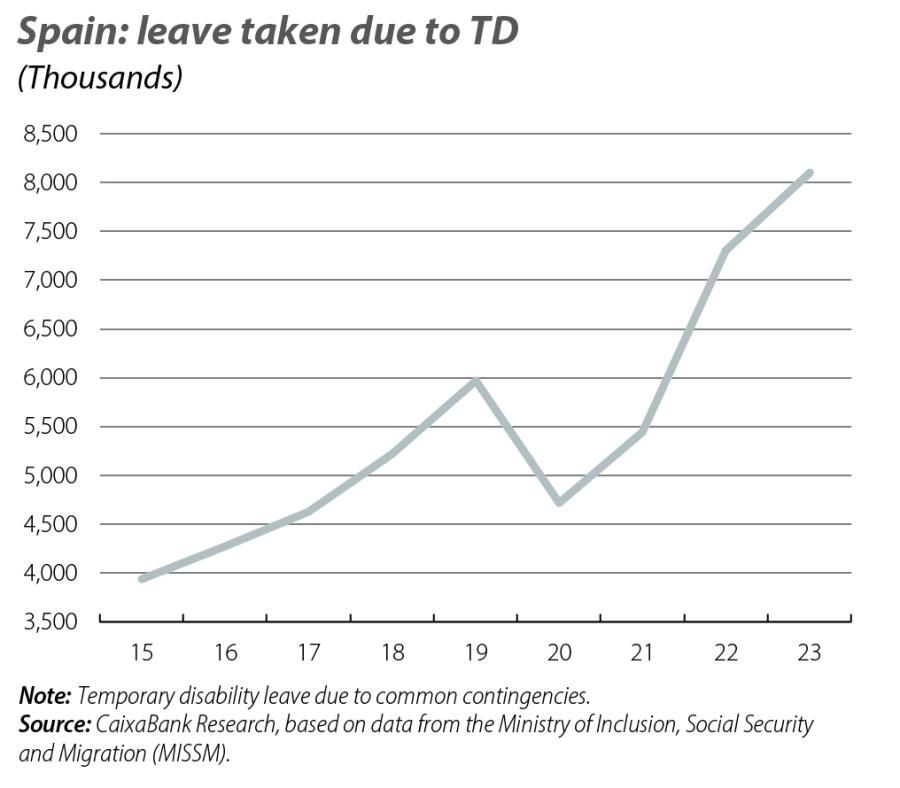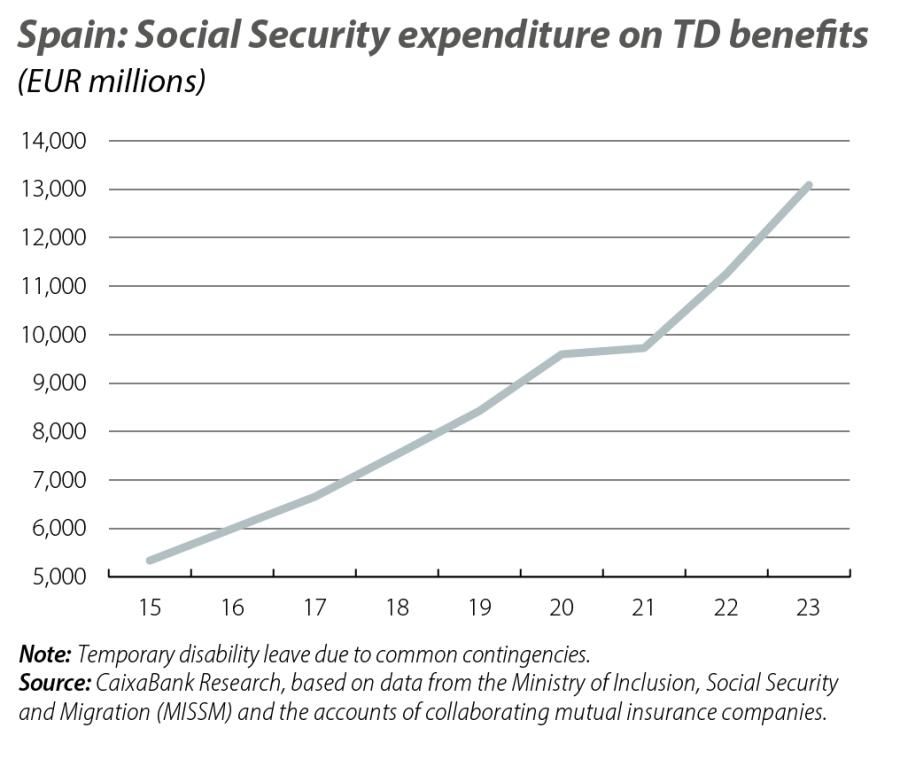The disparity between employment and hours worked in Spain
While employment in Spain far exceeds pre-pandemic levels, the number of hours actually worked has grown at a slower pace since then. The significant increase in absenteeism due to temporary disability has been one of the main factors behind this trend.

After leaving the COVID-19 crisis behind us, Spain’s labour market is in good shape. Employment far exceeds pre-pandemic levels. Specifically, in Q1 2024 it was already more than 8% above the levels of Q1 2019 (in National Accounting terms)1 and its cumulative growth is double that of GDP, at 3.7%. In contrast, the number of actual hours worked has grown at a slower rate since then, by just 1.3%. This has resulted in a 6.3% decline in the number of hours worked per worker (referring to full-time equivalent job positions, known as PTETC). Thus, while productivity per worker has accumulated a fall of 4.0%, productivity per hour worked has grown by 2.5%.
- 1. In terms of full-time equivalent job positions (known as PTETC).

What is the decrease in the number of hours worked per employee attributable to? It does not appear to be due to a change in the composition of employment between full-time and part-time workers. After all, according to the LFS, while the number of people in full-time employment has increased by 10.5% since Q1 2019, the number in part-time employment has only grown by 1.4%. One factor that does appear to have caused this trend, however, is the greater number of hours of absenteeism from work, due to a variety of reasons.
According to data from the LFS, in Q1 2024, 9.8% of those in employment (almost 2.1 million people) did not work in the week of reference: 885,000 due to holidays, 113,000 due to parental leave and, above all, 971,000 due to sickness, accidents or temporary disability (TD).2
- 2. As defined by the Ministry of Inclusion, Social Security and Migration (MISSM), this is the inability to work due to common or occupational illness, a workplace or other accident, disabling menstruation or termination of pregnancy.

According to data from Social Security (S.S.),3 the percentage of hours not worked for various reasons other than holiday leave amounted to 6.3% of all paid hours in Q4 2023, compared to 4.8% in Q4 2019. 86.2% of the hours not worked were due to TD leave, 12.8% due to other benefits (parental leave following a birth and care of minors or due to risk during pregnancy or lactation) and 1.0% due to being on furlough (ERTE). The average number of hours not worked per contributor to the General Scheme stood at 27.5 in the quarter, seven hours more than in the same period in 2019.
- 3. Quarterly report on paid hours and actual hours: Social security: Statistics (seg-social.es). This is a set of statistics based on administrative data, prepared using data on the social security contributions paid by companies; the series starts in Q1 2019.

In 2023 as a whole, the total paid hours grew by 10.8% compared to 2019, while the actual hours worked increased by 9.1%. The average number of hours not worked per contributor in the year rose to 107.5 (6.1% of the paid hours), compared to 80.3 in 2019 (4.7% of the paid hours). The number of hours not worked in the year is equivalent to the employment of almost one million people.
The hours not worked due to TD accounted for 5.4% of the paid hours in Q4 2023 (4.0% prior to the pandemic). Since Q4 2019, the hours not worked for this reason have grown by no less than 48.3%, almost five times more than the total paid hours.

If we refer to the National Statistics Institute’s quarterly labour cost survey,4 the results we obtain are very similar to those mentioned above, albeit somewhat more up-to-date and disaggregated by economic sector and segment. In this case, total absenteeism stood at 6.8% of the agreed hours5 in Q1 2024, which is 0.2 pps more than in the previous quarter and the highest ratio since Q1 2022. Considering only absenteeism due to TD, the rate in Q1 was 5.2% (5.0% in Q4 2023). Both figures clearly exceed those prior to the outbreak of the pandemic (Q1 2019): 5.2% for total absenteeism and 3.8% for absenteeism due to TD.
- 4. This is a survey with extensive coverage, encompassing a sample of some 28,000 companies across the country, including all those with more than 500 workers.
- 5. Hours not worked, excluding absences due to holiday leave and bank holidays; it therefore includes days of leave due to TD; days of leave due to maternity, adoption and personal reasons; time off as compensation for overtime, etc. As for the agreed hours, these are the hours that are legally established by verbal agreement, individual contract or collective agreement between the worker and the company.

By economic segment, the highest absenteeism in Q1 2024, with rates in excess of 8.0%, corresponded to administrative activities, general government, water supply and, above all, health, where it reached 10.5% of the agreed hours. In contrast, in professional and real estate activities the rate was less than 4.0%. In comparison with the same quarter of 2019, there has been an increase in absenteeism across the board, with the exception of real estate activities, where it reduced very slightly (by just 0.2 pps). The biggest increases (greater than 2 points) are found in water supply, administrative activities and other services. On the other hand, this analysis shows a high dispersion of absenteeism by economic segment, which has even widened in recent years: whereas in 2019 the difference between the highest and lowest rate was 5.2 points, in 2024 it is 7.3 points.

The increase in absenteeism is observed in virtually all euro area countries, suggesting that what has happened in recent years has had a persistent and widespread impact. If we compare the ratio of Spanish absenteeism from work with those of other euro area countries, Spain is near the top of the ranking, albeit below economies such as Germany and France. However, Spain stands out for the sharp growth in absenteeism which it has experienced since the pandemic. In fact, our country has seen the second biggest growth in absenteeism relative to the same quarter in 2019, specifically of 4 points, behind only Malta. If we exclusively consider absenteeism due to TD, the increase versus Q1 2019 has also been significant, going from 2.7% to 4.6%.

If we focus on absenteeism from work caused by TD, the figures speak for themselves: in 2023 over 8.1 million cases of leave due to common contingency were recorded, costing the S.S. system over 13 billion euros in economic benefits. These figures exceed those of 2019 by 36% and 55%, respectively.6
- 6. In addition to this, we should consider the cost assumed by companies themselves: on the one hand, the direct costs, derived from (i) the economic benefit between days 4 and 15, (ii) the supplements and improvements which, where applicable, may be included in collective labour agreements, and (iii) the S.S. contributions which they must continue to pay while the employee is on leave; on the other hand, the indirect costs, associated with the value of the goods and services that are not being produced. For further information, see the report published by AMAT (2024), «El absentismo laboral derivado de la incapacidad temporal por contingencias comunes (ITCC)» corresponding to 2023.

The increase in absenteeism has resulted from the increase in the number of cases rather than the average duration of leave, which is even below pre-pandemic levels; specifically, the average duration of the temporary common contingency disability processes (known as ITCC) completed last year was slightly over 36 days for workers with an employment contract, compared to 38.6 days on average in 2015-2019. Despite this decrease in the average duration, there has been a sharp increase in the number of long-term ITCC cases lasting more than 365 days, with the count as of December 2023 rising to 100,734, compared to 32,664 cases at the end of 2019. This increase could be due to delays in the processing of permanent disability cases.

The increase in absenteeism due to TD, without going into the multitude of causes that lead to it, has a negative impact on companies’ productivity and labour costs, especially in the case of SMEs. Moreover, it increases the costs for the S.S. system, as well as the bureaucratic burden on the healthcare system. In order to continue to effectively support workers who are unable to work, it is essential to streamline this bureaucratic and care burden. Moreover, it is essential that cases are properly managed and inspected in order to tackle abusive practices and inefficiencies, and that there is greater collaboration between the S.S. system and health insurance companies in order to reduce the pressure on the health services.
- 1. In terms of full-time equivalent job positions (known as PTETC).
- 2. As defined by the Ministry of Inclusion, Social Security and Migration (MISSM), this is the inability to work due to common or occupational illness, a workplace or other accident, disabling menstruation or termination of pregnancy.
- 3. Quarterly report on paid hours and actual hours: Social security: Statistics (seg-social.es). This is a set of statistics based on administrative data, prepared using data on the social security contributions paid by companies; the series starts in Q1 2019.
- 4. This is a survey with extensive coverage, encompassing a sample of some 28,000 companies across the country, including all those with more than 500 workers.
- 5. Hours not worked, excluding absences due to holiday leave and bank holidays; it therefore includes days of leave due to TD; days of leave due to maternity, adoption and personal reasons; time off as compensation for overtime, etc. As for the agreed hours, these are the hours that are legally established by verbal agreement, individual contract or collective agreement between the worker and the company.
- 6. In addition to this, we should consider the cost assumed by companies themselves: on the one hand, the direct costs, derived from (i) the economic benefit between days 4 and 15, (ii) the supplements and improvements which, where applicable, may be included in collective labour agreements, and (iii) the S.S. contributions which they must continue to pay while the employee is on leave; on the other hand, the indirect costs, associated with the value of the goods and services that are not being produced. For further information, see the report published by AMAT (2024), «El absentismo laboral derivado de la incapacidad temporal por contingencias comunes (ITCC)» corresponding to 2023.


